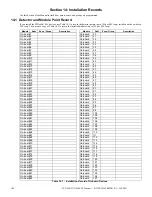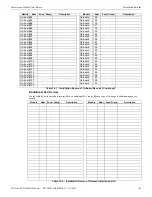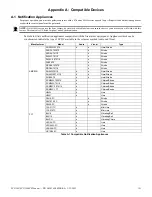
FCP-300/FCP-300ECS Manual —
P/N LS10145-002FK-E:A 3/12/2021
145
Section 13: Testing and Troubleshooting
13.1 Troubleshooting
This Section of the Manual offers suggestions for troubleshooting hardware problems. Please read this section if you encounter a
problem when installing the control panel. If these suggestions do not solve your problem or if you encounter a problem that is not listed
here, for assistance contact Fike Technical Support at 800-979-FIKE (3453) (www.fike.com).
Common Problems:
Problem
Possible Cause / Suggested Actions
Trouble message “DBL ADDR” (Double
Address) displays on LCD.
An address has been assigned to more than one detector. Correct the address following the
procedure described in Section Section 7.1 for FIK devices or Section 7.2 for SK devices, &
Section Section 7.3 for SD devices
Auxiliary power or notification circuits have
incorrect polarity.
Correct polarity. For notification and auxiliary power circuits: When in alarm or powered,
terminals labeled “X” are positive, terminals labeled “O” are negative.
SLC devices are not being recognized
(trouble message “Missing” displays).
Check hardware connections.
If devices are physically connected, make sure wiring is correct (see Section Section 7.9 for
SD devices and Section 7.7 for FIK or SK devices). For the main panel, the positive side of
device must be connected to terminal 34; the negative side must be connected to Terminal
33. For SLC devices, make sure the device connects to the SLC loop via the SLC OUT
terminals.
Make sure SLC devices have been addressed properly following the procedure described in
Section 7.10for SD devices and Section 7.8 for FIK or SK devices.
For contact monitor modules, which are addressed using DIP switches, the DIP switch must
be set to the correct address before power is applied to the SLC loop. If this procedure is not
followed, the device will have an incorrect address.
Make sure correct polarity has been observed for SLC device wiring. See Section 7.9for SD
devices and Section 7.6 for Fike or Silent Knight devices.
SLC devices are not being recognized
(trouble message “Missing” displays on the
annunciator).
Check that SLC loop impedance is within the required range.
To measure impedance, use the following procedure.
1. Disconnect both wires from the terminal block at the panel (SLC devices can remain
connected).
2. Measure the impedance from positive to negative and from negative to positive. Both
measurements should be greater than 500 K ohms. If the installation uses T-taps, test
each T-tap individually.
3. Temporarily connect the positive wire to the negative wire of the SLC loop at the point far-
thest from the panel (SLC devices can remain connected).
4. Measure the impedance from positive to negative and from negative to positive. Both
measurements must be less than 50 ohms.
The panel indicates a ground fault trouble
condition (trouble message “GROUND
FAULT” displays).
An earth ground fault occurs when the panel senses an unexpected flow of current from one
or more of its terminals to the earth connection (Terminal 2).
Isolate the wiring that is causing the fault by removing wiring connections one at a time until
the earth fault is no longer present. Pause at least five seconds after removing a wire before
removing the next one.
The panel will also go into ground fault if a computer is connected to the panel via a serial
cable attached to the panel’s 9-pin connector or a USB cable. This is a correct method for on-
site communication between a panel and a computer. Ignore the ground fault message in this
case. The trouble will clear automatically when you disconnect the computer from the cable
FIK-5496 module that has been physically
connected to the panel but is not being
recognized.
Check the status of the FIK-5496 green LED. If it flashes in the pattern.5 sec on /.5 sec. off, it
is likely that the FIK-5496 has not been added to the System through programming.
JumpStart will add any FIK-5496s connected to the panel. If you have already run JumpStart,
FIK-5496s can be added manually (see Section 9.2.2).
Check that the correct ID for the FIK-5496 module has been set through the DIP switches.
Assign ID#1 to the first FIK-5496 and ID#2 to the second FIK-5496. If the wiring between the
FIK-5496 and the panel is correct, measure the voltage from FIK-5496 Terminal (+) to
Terminal (-). Voltage should be in the range 27.2-27.4V when AC power is present.
If the green LED is not flashing, the likely cause is incorrect wiring from between the FIK-5496
and the panel.
Table 13.1 Troubleshooting Chart
Summary of Contents for FCP-300
Page 169: ...Cut Along the Dotted Line ...
Page 171: ...Cut Along the Dotted Line ...
Page 173: ...Cut Along the Dotted Line ...
Page 175: ...Cut Along the Dotted Line ...



































